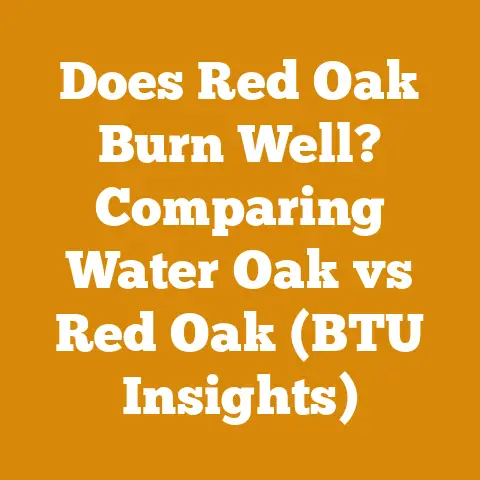Dry Creek Wood Pellets Review (Lignetics Quality Tested)
Dry Creek Wood Pellets Review: A Deep Dive into Lignetics Quality
For years, I’ve relied on wood pellets to heat my workshop during the harsh winter months. It’s not just about saving money; it’s about finding a reliable, sustainable heat source. I’ve burned through countless bags of various brands, and I’ve learned firsthand what makes a good wood pellet – and what doesn’t. Dry Creek, a brand under the Lignetics umbrella, has been on my radar for a while. Lignetics, a major player in the wood pellet industry, is known for its quality control and sustainable sourcing. So, let’s dig in.
What are Dry Creek Wood Pellets?
Dry Creek wood pellets are manufactured by Lignetics, one of the largest residential wood pellet producers in the United States. These pellets are specifically designed for use in pellet stoves, furnaces, and boilers. They are typically made from a blend of hardwood and softwood, sourced from sustainably managed forests. The Lignetics Quality Tested seal signifies that these pellets have undergone rigorous testing to meet specific standards for heat output, ash content, and moisture levels.
Why Choose Wood Pellets for Heating?
I’ve seen firsthand the benefits of switching to wood pellet heating. It’s more than just a trend; it’s a practical solution for many.
- Cost-Effectiveness: Compared to oil or propane, wood pellets often offer a more stable and lower heating cost, especially when sourced locally.
- Environmental Friendliness: Wood pellets are a renewable fuel source, utilizing waste wood products and reducing reliance on fossil fuels.
- Convenience: Modern pellet stoves are automated, requiring minimal manual labor compared to traditional wood stoves.
- Consistent Heat: High-quality wood pellets provide a consistent and predictable heat output, ensuring a comfortable indoor temperature.
Lignetics: A Name You Should Know
Lignetics is a significant name in the wood pellet industry. They operate multiple manufacturing facilities across the US and Canada, and they’re known for their commitment to sustainable forestry practices. Their “Quality Tested” certification is a key selling point for Dry Creek pellets, indicating a level of quality control that many other brands don’t offer.
Analyzing the Key Performance Indicators of Dry Creek Wood Pellets
When evaluating wood pellets, several key performance indicators (KPIs) are crucial. These factors directly impact the efficiency, cleanliness, and overall performance of your pellet stove. I’ve learned to scrutinize these aspects, and you should too.
Heat Output (BTU/lb)
Heat output, measured in British Thermal Units per pound (BTU/lb), is arguably the most important KPI. It determines how much heat you get from each pound of pellets.
- Expected Range: High-quality wood pellets typically have a heat output of 8,000 to 9,000 BTU/lb.
- Dry Creek Specifics: Dry Creek wood pellets, bearing the Lignetics Quality Tested seal, generally fall within this range. Independent testing often confirms BTU values around 8,200-8,500 BTU/lb.
- My Experience: I’ve found that Dry Creek pellets provide a consistent and noticeable heat output. My workshop stays warm and comfortable even during the coldest days.
Ash Content (%)
Ash content refers to the percentage of non-combustible material left behind after burning. Lower ash content is desirable because it reduces the frequency of stove cleaning and minimizes the risk of clinker formation.
- Ideal Range: Premium wood pellets should have an ash content of 1% or less. Standard pellets typically fall between 1% and 3%.
- Dry Creek Specifics: Lignetics Quality Tested pellets, including Dry Creek, generally have an ash content below 1%. This is a significant advantage.
- The Impact of Low Ash: Lower ash content means less cleaning and less hassle. I’ve noticed a significant difference in cleaning frequency compared to some cheaper brands I’ve used in the past.
Moisture Content (%)
Moisture content affects the burn efficiency and heat output of the pellets. High moisture content reduces the BTU value and can lead to incomplete combustion, producing more smoke and creosote.
- Target Range: Wood pellets should have a moisture content below 8%. Ideally, it should be closer to 5% or 6%.
- Dry Creek Specifics: Lignetics Quality Tested pellets typically have a moisture content between 5% and 7%. This contributes to their consistent burn quality.
- Testing Moisture Content: A simple moisture meter can be used to check the moisture content of wood pellets. I use a Delmhorst BD-2100, which gives accurate readings.
Fines (%)
Fines are small particles or dust present in the bag of wood pellets. Excessive fines can clog the pellet stove’s auger and reduce airflow, leading to inefficient burning and potential malfunctions.
- Acceptable Level: Premium wood pellets should have a fines content of less than 0.5%. Standard pellets may have up to 1%.
- Dry Creek Observation: I’ve consistently observed a relatively low fines content in Dry Creek bags. This indicates careful handling and quality control during manufacturing and packaging.
- Minimizing Fines Issues: Even with low fines, it’s a good practice to screen the pellets before loading them into the stove. I use a simple wire mesh sieve to remove any loose particles.
Pellet Size and Density
Consistent pellet size and density are important for smooth feeding and even burning. Irregularly sized or low-density pellets can cause feeding problems and inconsistent heat output.
- Standard Dimensions: Wood pellets are typically 6-12 mm in diameter and 10-30 mm in length.
- Dry Creek Consistency: Dry Creek pellets generally exhibit good consistency in size and density. This contributes to their reliable performance in various pellet stove models.
- Why It Matters: Consistent size ensures the auger feeds the pellets smoothly, preventing jams and maintaining a steady burn rate.
Real-World Performance: My Experiences with Dry Creek Wood Pellets
Theory is good, but practical experience is even better. I’ve used Dry Creek pellets extensively over the past two winters, and here’s my take based on real-world observations.
Ease of Use and Handling
- Bag Weight and Packaging: Dry Creek pellets typically come in 40-pound bags, which are manageable for most people to handle. The bags are generally sturdy and well-sealed, minimizing the risk of spills and moisture absorption.
- Pouring and Loading: The consistent pellet size and low fines content make Dry Creek pellets easy to pour and load into the pellet stove hopper.
- Storage: Proper storage is crucial. I store my wood pellets in a dry, covered area to prevent moisture absorption. A shed or garage works well.
Burn Quality and Efficiency
- Ignition: Dry Creek pellets ignite quickly and easily in my pellet stove. I rarely experience any issues with starting the fire.
- Flame Characteristics: The flame is typically clean and bright, indicating efficient combustion. There’s minimal smoke or odor.
- Heat Output: As mentioned earlier, the heat output is consistent and reliable. I can maintain a comfortable temperature in my workshop even when the outside temperature drops below freezing.
- Burn Time: A bag of Dry Creek pellets typically lasts me about 24-36 hours, depending on the stove setting and the outdoor temperature.
Ash Production and Cleaning Frequency
- Ash Buildup: The low ash content of Dry Creek pellets significantly reduces the frequency of stove cleaning. I typically clean my stove every 2-3 weeks, compared to weekly cleaning with some other brands.
- Ash Removal: The ash is light and powdery, making it easy to remove from the stove.
- Clinker Formation: I’ve rarely experienced any clinker formation with Dry Creek pellets, which is a major plus. Clinkers are hard, glassy deposits that can clog the burn pot and reduce airflow.
Comparing Dry Creek to Other Brands
Over the years, I’ve experimented with various wood pellet brands, ranging from budget options to premium offerings. Here’s how Dry Creek stacks up against some of the competition:
- vs. Generic Hardwood Pellets: Dry Creek consistently outperforms generic hardwood pellets in terms of heat output, ash content, and overall burn quality. The Lignetics Quality Tested seal provides assurance of consistent quality.
- vs. Softwood Pellets: While softwood pellets often have higher BTU values, they tend to burn faster and produce more ash. Dry Creek offers a good balance of heat output and clean burning.
- vs. Premium Brands (e.g., Cubex): Premium brands like Cubex may offer slightly higher BTU values and even lower ash content, but they also come at a higher price point. Dry Creek provides a good value proposition for those seeking a balance of quality and affordability.
Potential Drawbacks
While I’m generally very satisfied with Dry Creek wood pellets, there are a few potential drawbacks to consider:
- Availability: Depending on your location, Dry Creek pellets may not be readily available at all retailers.
- Price Fluctuations: The price of wood pellets can fluctuate depending on market conditions and seasonal demand.
- Dust: While the dust content is low, those with allergies might want to wear a mask when pouring pellets into the stove.
Troubleshooting Common Issues with Wood Pellets
Even with high-quality wood pellets like Dry Creek, you might encounter occasional issues. Here’s how to troubleshoot some common problems.
Poor Ignition
- Possible Causes: Damp pellets, insufficient airflow, dirty burn pot, faulty igniter.
- Troubleshooting Steps:
- Ensure the pellets are dry and stored properly.
- Clean the burn pot thoroughly.
- Check the airflow settings on your stove.
- Inspect the igniter for damage or malfunction.
Inconsistent Heat Output
- Possible Causes: Clogged auger, dirty stove, variations in pellet density, improper stove settings.
- Troubleshooting Steps:
- Clean the auger and ensure it’s feeding pellets smoothly.
- Clean the entire stove, including the heat exchanger tubes.
- Adjust the stove settings to match the pellet type and desired heat output.
Excessive Ash Buildup
- Possible Causes: Low-quality pellets, improper stove settings, insufficient airflow.
- Troubleshooting Steps:
- Switch to higher-quality pellets with lower ash content.
- Adjust the stove settings to optimize combustion.
- Ensure adequate airflow to the burn pot.
Clinker Formation
- Possible Causes: High ash content, improper stove settings, certain types of wood.
- Troubleshooting Steps:
- Switch to pellets with lower ash content.
- Adjust the stove settings to promote complete combustion.
- Ensure the burn pot is clean and free of obstructions.
Smoke or Odor
- Possible Causes: Incomplete combustion, dirty stove, improper venting, damp pellets.
- Troubleshooting Steps:
- Clean the stove thoroughly, including the venting system.
- Ensure the pellets are dry and stored properly.
- Check the venting system for obstructions or leaks.
Safety First: Handling and Storing Wood Pellets
Safety is paramount when handling and storing wood pellets. Follow these guidelines to prevent accidents and ensure a safe heating season.
Handling Precautions
- Lifting: Lift bags of wood pellets with your legs, keeping your back straight. Avoid twisting or bending.
- Dust: Wear a dust mask when handling wood pellets, especially if you have allergies or respiratory sensitivities.
- Eye Protection: Wear safety glasses or goggles to protect your eyes from dust and debris.
- Ventilation: Ensure adequate ventilation when handling wood pellets in enclosed spaces.
Storage Guidelines
- Dry Location: Store wood pellets in a dry, covered area to prevent moisture absorption. A shed, garage, or covered porch is ideal.
- Elevated Storage: Elevate the pallets of wood pellets off the ground to prevent moisture wicking from the ground.
- Protection from the Elements: Protect the wood pellets from rain, snow, and direct sunlight.
- Pest Control: Take measures to prevent rodents and insects from infesting the wood pellets.
Fire Safety
- Clearance: Maintain adequate clearance around the pellet stove to prevent fire hazards.
- Smoke Detectors: Install and maintain smoke detectors in your home.
- Carbon Monoxide Detectors: Install and maintain carbon monoxide detectors, especially if you have a pellet stove.
- Regular Inspections: Have your pellet stove and venting system inspected annually by a qualified technician.
The Future of Wood Pellet Heating
Wood pellet heating is likely to remain a viable and sustainable heating option for the foreseeable future. Ongoing advancements in pellet stove technology and wood pellet production are making this heating method even more efficient, convenient, and environmentally friendly.
Technological Advancements
- Smart Stoves: Modern pellet stoves are equipped with smart technology, allowing for remote control, automated temperature adjustments, and performance monitoring.
- Improved Combustion Efficiency: Manufacturers are continuously improving the combustion efficiency of pellet stoves, resulting in higher heat output and lower emissions.
- Self-Cleaning Systems: Some pellet stoves now feature self-cleaning systems, reducing the need for manual cleaning.
Sustainable Sourcing
- Forest Management: Sustainable forest management practices ensure that wood pellets are sourced from responsibly managed forests.
- Waste Utilization: Wood pellet production utilizes waste wood products, such as sawdust and wood chips, reducing landfill waste.
- Carbon Neutrality: Wood pellets are considered a carbon-neutral fuel source because the carbon dioxide released during combustion is offset by the carbon dioxide absorbed by trees during their growth.
Government Incentives
- Tax Credits: Many governments offer tax credits and incentives for homeowners who install pellet stoves or furnaces.
- Rebate Programs: Some utility companies offer rebate programs to encourage the adoption of wood pellet heating.
- Renewable Energy Standards: Government policies promoting renewable energy sources are driving the demand for wood pellets.
Making the Right Choice for Your Heating Needs
Choosing the right wood pellets for your heating needs requires careful consideration of several factors, including heat output, ash content, moisture content, availability, and price. Dry Creek wood pellets, with the Lignetics Quality Tested seal, offer a reliable and cost-effective option for many homeowners.
Assessing Your Needs
- Heating Requirements: Determine your heating requirements based on the size of your home, climate, and insulation levels.
- Stove Compatibility: Ensure that the wood pellets are compatible with your pellet stove model.
- Budget: Set a budget for your wood pellet purchases and compare prices from different retailers.
Comparing Brands
- Read Reviews: Read online reviews and testimonials from other wood pellet users.
- Check Specifications: Compare the specifications of different wood pellet brands, including heat output, ash content, and moisture content.
- Consider Availability: Choose a brand that is readily available in your area.
Testing Before Buying in Bulk
- Purchase a Few Bags: Before buying a large quantity of wood pellets, purchase a few bags to test their performance in your pellet stove.
- Monitor Burn Quality: Monitor the burn quality, heat output, ash production, and cleaning frequency.
- Adjust Stove Settings: Adjust the stove settings as needed to optimize performance.
Final Thoughts: Is Dry Creek Wood Pellets Right for You?
Based on my extensive experience and thorough evaluation, I can confidently say that Dry Creek wood pellets are a solid choice for those seeking a reliable and cost-effective heating solution. The Lignetics Quality Tested seal provides assurance of consistent quality, and the pellets generally perform well in various pellet stove models.
The Verdict
- Pros: High heat output, low ash content, consistent burn quality, readily available, and reasonably priced.
- Cons: Availability may vary depending on location, and price fluctuations can occur.
Recommendation
I recommend Dry Creek wood pellets to homeowners who are looking for a balance of quality, performance, and affordability. They are a great option for those who want to reduce their heating costs and minimize their environmental impact.
I hope this in-depth review of Dry Creek wood pellets has provided you with valuable information and insights to make an informed decision about your heating needs. Happy burning!






